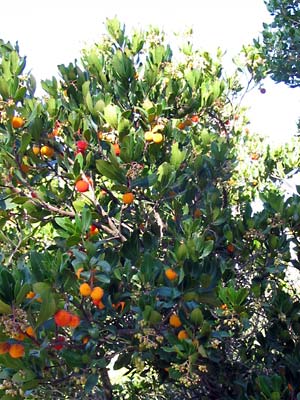 The strawberry tree (Arbutus unedo) is a tragic shrub, its ubiquity simply serving to remind one that it’s B-list vegetation. As with many things we can blame the Romans. Take Virgil. Aeneas has a bier made from oak twigs and strawberry tree shoots for poor old Pallas, but then Virgil goes and spoils it all by comparing the slain youth with the violet and the fleur-de-lis. Neither really bad nor really good for you, apparently its name implies that it will only be tried once (which might have something to do with its allegedly narcotic qualities). And there’s more tepid eulogising to come:
The strawberry tree (Arbutus unedo) is a tragic shrub, its ubiquity simply serving to remind one that it’s B-list vegetation. As with many things we can blame the Romans. Take Virgil. Aeneas has a bier made from oak twigs and strawberry tree shoots for poor old Pallas, but then Virgil goes and spoils it all by comparing the slain youth with the violet and the fleur-de-lis. Neither really bad nor really good for you, apparently its name implies that it will only be tried once (which might have something to do with its allegedly narcotic qualities). And there’s more tepid eulogising to come:
Horace praises the tree for its shade and Ovid for its loads of ‘blushing fruit.’ Virgil recommends the young shoots as winter food for goats and for basket-work… The wood of the tree makes good charcoal.
A bear trying to get at the fruit of a strawberry tree dominates Madrid’s municipal emblem (and the Puerta del Sol statue). Promising indeed, but we rapidly discover that the madroño is only there because there were a lot of them around Madrid in the early C13th. I haven’t yet found local literature celebrating the humble arboç, and Catalan ants consume without any particular enthusiasm what the birds leave behind.
Further north, on the edge of the world, the strawberry tree’s boisterous colours tend to be noted without any particular affection amidst Ireland’s overwhelming green; Hancock’s description of how the population there came to be isolated from its Mediterranean heartland merely adds to a sense of desolation. However it’s old misery-guts Melvin B Tolson who – in this scrap from Harlem Gallery – withers the strawberry tree for good:
Like the lice and maggots of the apples of Cain
on a strawberry tree,
the myth of the Afroamerican past
exacts the parasite’s fee.
Very profound, but what on earth does it really mean?
Thankyous to designsonyourgarden.com, kaleboel’s plant consultant.
Similar posts
Back soon
Comments